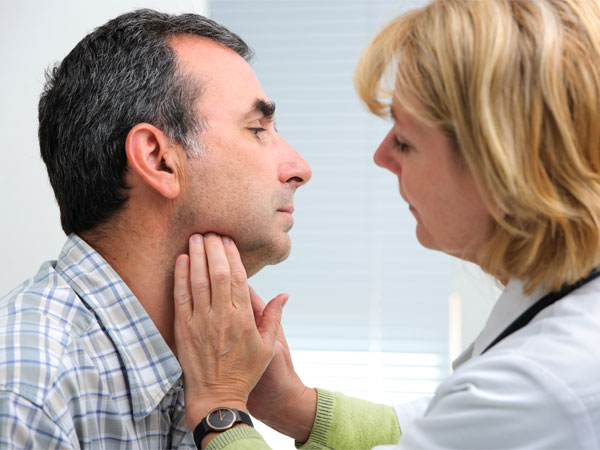- Home
- Science
- Diseases & Conditions
- Hodgkin Lymphoma
What is Hodgkin Lymphoma?
Hodgkin lymphoma (HL, also known as Hodgkin disease) is a type of cancer that first starts in the lymphatic system.1 The lymphatic system is a part of the body’s immune system—it helps the body fight bacteria and other infections while also destroying old or abnormal cells, including cancer cells.2
The lymphatic system is made up of lymph nodes, the thymus gland, the tonsils, the spleen, and bone marrow.1 A system of thin tubes runs throughout the body connecting all parts of the lymphatic system.2 Lymphocytes, a type of white blood cell, circulate through the lymphatic system in a clear fluid called lymph.2
Hodgkin lymphoma is one of two main types of lymphoma. The other is non-Hodgkin lymphoma (NHL). Hodgkin lymphoma first develops in B lymphocytes (B cells).2 These cancerous B cells eventually “crowd out” healthy cells, which ultimately compromises the immune system.3 In some cases, cancerous cells also form masses inside lymphatic tissues throughout the body, and they can affect other organs including the lungs, liver, or bones.2,3
Doctors differentiate between the two main types of lymphoma by looking at the cancerous lymphocytes under a microscope. Hodgkin lymphoma is characterized by the presence of large, abnormal white blood cells known as Reed-Sternberg (RS) cells and Hodgkin cells.2,4,5
This type of cancer can affect anyone, but it’s most common in early adulthood (age 20-39 years) and late adulthood (65 years and older).1
Fortunately, HL is one of the most curable forms of cancer, with a 5-year survival rate of 89 percent across cancer stages.3,6 Treatment usually includes chemotherapy, radiation therapy, targeted therapy, and immunotherapy.1
Prevalence of Hodgkin Lymphoma
Hodgkin lymphoma is more common among people aged 20-39 and those that are 65 years old or older.1 About 9,000 people will receive a HL diagnosis each year.4
Causes and Risk Factors
What Causes Hodgkin Lymphoma?

The exact causes of HL are unknown; however, factors associated with an increased risk of the disease include:7,8
- Age
- Being assigned male at birth
- Family history of HL
- Past Epstein Barr virus (EBV) infection
- Weakened immune system
Hodgkin Lymphoma and Genetics
Research suggests that a person may be at increased risk for developing HL if they have a first-degree relative, like a biological sibling, who had HL, NHL, or a condition called chronic lymphocytic leukemia (CLL). However, most people who develop this kind of cancer don’t have family members with the disease or other types of blood cancers. Ultimately, doctors don’t know whether HL develops due to inherited genetic changes.8
Hodgkin Lymphoma Risk Factors
Risk factors increase a person’s likelihood of developing Hodgkin lymphoma. While one or more of these risk factors may put you at higher risk, there is no guarantee you will develop HL if you have one or more risk factors.7
Common risk factors for HL include:7
- Age
- Being overweight
- Biological sex
- Family history
- Past EBV infection
- Smoking
- Weakened immune system
Hodgkin Lymphoma Prevention
There is no way to guarantee you will never develop HL. Fortunately, the risk of developing HL is small since the disease is not common. You can help to reduce your risk by making healthy lifestyle choices, such as not smoking and maintaining a healthy weight.7
Types of Hodgkin Lymphoma
There are two types of Hodgkin lymphoma: classical Hodgkin lymphoma (cHL) and nodular lymphocyte-predominant HL (NLPHL). Classical HL is much more common, accounting for nine out of every 10 cases.9
Classical HL is further classified into four main subtypes:9
- Nodular sclerosis HL (NSCHL) is the most common subtype, accounting for about seven in every 10 cases. This type of HL is more common in teens and young adults. It usually begins in the neck or chest.
- Mixed cellularity HL (MCCHL) is the second most common type and makes up about four in every 10 cases. It’s mostly found in people living with HIV infection. It can also occur in children and the elderly.
- Lymphocyte-depleted HL is a rarer, more aggressive form of HL compared to others. This type of HL is more likely to be advanced when first diagnosed.
- Lymphocyte-rich HL isn’t common. If it occurs, it usually starts in the upper portion of the body.
Nodular lymphocyte-predominant HL (NLPHL) accounts for about 5 percent of all cases. In most cases, NLPHL grows slowly, usually starting in the lymph nodes in the neck or armpit. It’s also more common in people assigned male at birth.9
Hodgkin Lymphoma Symptoms

The most common symptom of HL is one or more swollen or enlarged lymph nodes, which are usually painless. Other possible symptoms may include:10
- Abdominal pain
- Cough or shortness of breath that won’t go away
- Fatigue
- Unexplained fever
- Itching
- Loss of appetite
- Drenching night sweats
- Pain in lymph nodes after consuming alcoholic beverages
- Unexplained weight loss
Another group of symptoms, known as B symptoms, helps doctors further understand how advanced HL may be when making a diagnosis. B symptoms include:10
- Drenching night sweats
- Unexplained fever
- Unintentional loss of more than 10 percent of body weight over the past six months
You should keep in mind that many of the symptoms of HL are the same as those of other diseases, many of which are less serious. Visit your doctor if you have any symptoms that concern you.10
Diagnosis and Treatment
Hodgkin Lymphoma Diagnosis
Doctors use several diagnostic tests to confirm the presence of Hodgkin lymphoma. Generally, the process begins with a discussion of your medical history, followed by a complete physical examination.11
- Lymph node biopsy
A lymph node biopsy is always needed to confirm a Hodgkin lymphoma diagnosis. There are three types of biopsies that provide more information:12
- Excisional biopsies, in which doctors remove the entire lymph node.
- Incisional biopsies, where doctors only remove a portion of the lymph node.
- Needle biopsies, where doctors remove a small tissue sample from a lymph node using a small needle.
After collecting a sample, a laboratory test known as immunophenotyping may help detect cancer cells by identifying specific proteins located on the surface of Reed-Sternberg cells.11,12
- Imaging tests
Imaging tests are also an important part of the diagnostic process. Your doctor may suggest:11
- Computerized tomography (CT) scan
- Positron emission tomography (PET)-CT scan
- Chest X-ray
- Other diagnostic tests
Doctors may recommend additional testing to help determine the extent of the disease and the suitability of specific treatments. For example, a bone marrow biopsy may be performed after diagnosis to see if there are any lymphoma cells in the bone marrow.11
Blood tests also help doctors determine how advanced Hodgkin lymphoma is and whether a person may be able to tolerate certain treatments.12 Blood tests usually include:11
- Complete blood count (CBC)
- Comprehensive metabolic panel (CMP)
- Erythrocyte sedimentation rate (ESR)
- Lactate dehydrogenase (LDH)
- Liver and kidney function
- HIV and Hepatitis B tests
In some cases, doctors suggest tests that measure heart and lung function, like electrocardiogram (ECG) or pulmonary function tests (PFTs), if certain chemotherapy medicines are part of the treatment plan.12 This is because some chemotherapy medications have side effects that may affect the heart or lungs.11
Staging Hodgkin Lymphoma
After making a positive diagnosis, your doctor will determine the stage of the cancer. The stage of a cancer describes how much cancer is in the body.13
Doctors use a system known as the Lugano classification system to stage Hodgkin lymphoma. The system has four stages:13
- Stage I: Hodgkin lymphoma is in only one lymph node or lymphoid organ like the thymus, or is only in one part of one organ outside the body’s lymphatic system.
- Stage II: HL is in two or more lymph nodes on the same side of a muscle known as the diaphragm, which separates the chest cavity from the abdomen. Or, HL has spread a small distance from a lymph node into a nearby organ.
- Stage III: HL cells are found in lymph nodes on both sides of the diaphragm. Alternatively, HL cells are found in lymph nodes above the diaphragm and in an organ called the spleen.
- Stage IV: Hodgkin lymphoma has spread into one or more organs outside the lymphatic system, like the bone marrow, liver, or lungs.
- A vs. B designation
Other information, such as the presence of B symptoms, further help doctors stage Hodgkin lymphoma. Generally, if a person has B symptoms, the disease is more advanced, and its stage receives a B designation (for example, stage IB). If no B symptoms exist, the disease receives an A designation.13
- Bulky disease
It’s also important to know whether Hodgkin lymphoma is “bulky.” The term bulky refers to tumors in the chest that are at least one-third as wide as the chest. Or, doctors may use the term when tumors in other areas are at least 10 centimeters (about 4 inches) across. If HL is bulky, doctors usually label it with an X.13
Hodgkin Lymphoma in Children
Hodgkin lymphoma may also affect children, usually between the ages of 15 and 19 years old. The most common risk factors among children include:14,15
- Certain genetic conditions, like ataxia-telangiesctasia, Nijmegen breakage syndrome, and Wiskott-Aldrich syndrome
- Certain infections, like HIV or EBV
- Family history of HL
- Weakened immune system
Symptoms of HL in children may include:14
- Fatigue
- Loss of appetite
- Night sweats
- Swollen, painless lymph nodes in the neck, armpits, or groin
- Unexplained fever
- Unexplained weight loss
The diagnostic and treatment processes are like those for adults. While a lymph node biopsy is the only way to definitively make a positive diagnosis, other diagnostic tests may be used, including blood tests with blood chemistry and CBC, and chest X-ray or CT scan.14
Doctors also use information from certain tests to stage the lymphoma. This means determining whether the cancer has spread outside the lymphatic system and, if so, how far. Staging tests may include a bone marrow biopsy, CT scan of the neck, chest, abdomen, or pelvis, or a PET scan.14
Treatment usually depends on several factors, including the child’s age, biological sex, and possible treatment side effects. Typical treatments for HL in children include chemotherapy, radiation therapy, immunotherapy, and stem cell transplant.14
Hodgkin Lymphoma Treatment
There is no one treatment approach that works for everyone. Instead, treatment teams develop treatment plans according to your age, overall health, the type of Hodgkin lymphoma you have, the stage of the disease, and whether you have other medical conditions, like heart disease. However, treatment often consists of one or a combination of therapies, including chemotherapy, radiation therapy, and immunotherapy. In some cases, stem cell transplant is also appropriate.16,17
- Chemotherapy
In most cases, chemotherapy for Hodgkin lymphoma consists of several powerful medications given in combination with each other to help kill cancer cells.18
Over the course of treatment, chemotherapy may cause side effects which may be unpleasant, such as hair loss, mouth sores, loss of appetite, nausea, fatigue, neuropathy, and easy bruising. It is common for doctors to periodically adjust chemotherapy regimens to help manage these side effects. In some cases, doctors switch medications; in others, they may start a new medication or discontinue an old one.18,19
- Radiation therapy
This type of treatment uses high-energy particles (rays) to directly target and destroy cancer cells. If you have classic HL, you may receive radiation after finishing treatment with chemotherapy, especially if a large or bulky tumor is present. People with NHLPL may receive radiation by itself.20
Treatment typically consists of external beam radiation delivered several times a week (often five days) for several weeks. Each treatment only lasts a few minutes. Your doctor may recommend:20
- Involved site radiation therapy (ISRT): A newer approach to radiation treatment, ISRT aims radiation only at the lymph nodes where HL first started growing and any nearby areas where the cancer may have spread. This means the treatment field is smaller, which helps to spare nearby tissues and organs from radiation damage.
- Involved field radiation therapy (IFRT): Although this is still in use, it is being replaced by ISRT. While IFRT only targets the regions with lymph nodes with HL cells, radiation may still reach nearby tissues or organs.
- Total body irradiation: This therapy is given to people receiving a stem cell transplant, usually along with high-dose chemotherapy.
Radiation therapy may result in side effects like fatigue, skin changes, dry mouth, and nausea.20
- Immunotherapy
Immunotherapy uses medicines to harness the power of the body’s own immune system, helping it to better identify and destroy cancer cells.21
Monoclonal antibodies
Monoclonal antibodies are human-made versions of immune system proteins (antibodies) that attack specific targets inside the body. Patients receive these medicines intravenously (IV) on a regular schedule that depends on the medicine being used. Available monoclonal antibodies for HL includerituximab.21
Antibody-drug conjugates
A newer class of medications, antibody-drug conjugates (ADCs) couple a monoclonal antibody with a chemotherapy drug. The antibody brings the chemotherapy medicine directly to cancer cells with matching cell surface proteins. Available ADCs for HL include brentuximab vedotin.21,22
Checkpoint inhibitors
Doctors also prescribe immune checkpoint inhibitors for those with Hodgkin lymphoma. These medications prevent cancer cells from “turning on” or “turning off” specific “checkpoint” proteins that prompt an immune system response. Patients usually receive immune checkpoint inhibitors through an IV infusion every two, three, or six weeks. Available checkpoint inhibitors for HL include nivolumab and pembrolizumab.21
- Stem cell transplant
In some cases, standard treatments, such as chemotherapy or radiation therapy, don’t make Hodgkin lymphoma go away completely. If this occurs, doctors may suggest a stem cell transplant. There are two main types of stem cell transplants:23
- Autologous stem cell transplant: First, doctors collect the patient’s own stem cells from the blood or bone marrow. They freeze the cells to store them while the person receives high-dose chemotherapy or radiation therapy. Then, the person’s own stem cells are injected back into the body through an IV.
- Allogeneic stem cell transplant: Doctors collect stem cells from a donor to give to the patient after high-dose chemotherapy or radiation therapy. Generally, doctors only recommend this approach if an autologous stem cell transplant wasn’t successful.
Global Impact of Hodgkin Lymphoma

Hodgkin lymphoma has the second highest cost per death, or lost productivity cost, following malignant melanoma.24 Additionally, people diagnosed with HL in childhood may experience physical side effects which may make normal functioning difficult. Emotional and psychological issues are also common in childhood HL survivors.25
A 2018 study also suggests how economically impactful a Hodgkin lymphoma diagnosis can be. The research indicates that people with HL who do not have success with first-line therapies use substantially more healthcare resources compared to those for which first-line treatments are successful. Over five years, patients undergoing at least two lines of treatment were expected to incur approximately $535,846 in healthcare costs.26
Frequently Asked Questions About Hodgkin Lymphoma
- What is lymphoma?
Lymphoma is a type of cancer that develops inside the body’s lymphatic system. Hodgkin lymphoma is one of two main types of lymphoma—the other is non-Hodgkin lymphoma.1
- What is Hodgkin lymphoma?
This type of lymphatic system cancer is characterized by the presence of Reed-Sternberg cells in laboratory samples.2
- What are the symptoms of Hodgkin lymphoma?
The most common HL symptom is one or more swollen, usually painless lymph nodes in the neck, upper chest, armpit, abdomen, or groin. Other common symptoms include:10
- Cough or shortness of breath that won’t go away
- Fatigue
- Unexplained fever
- Itching
- Loss of appetite
- Drenching night sweats
- Unexplained weight loss
- Is Hodgkin lymphoma contagious?
No, it is not possible to catch HL from another person.3
- Is Hodgkin lymphoma curable?
Fortunately, Hodgkin lymphoma is a treatable and curable type of lymphoma with current therapies.3
- How do I get screened for Hodgkin lymphoma?
There is currently no widely recommended screening test for Hodgkin lymphoma.27
- How is Hodgkin lymphoma diagnosed?
After collecting your medical history and completing a physical examination, your doctor will use several tests to make an accurate diagnosis. These tests may include imaging tests like a PET-CT scan or X-ray. You may also have a biopsy of the suspected cancerous lymph node. A lymph node biopsy is the only way to confirm a Hodgkin lymphoma diagnosis.11
- If I’m diagnosed, where do I begin?
After receiving a diagnosis, your care team—which consists of clinicians from hematology and oncology—will develop a treatment plan based on several factors: your age and overall health, the stage of HL, and any other coexisting diseases or conditions. Treatments usually include some combination of chemotherapy, radiation therapy, or immunotherapy.11,16,17 Stem cell transplant may help people with hard-to-treat HL.21
Learn More About Hodgkin Lymphoma
Find a Pfizer trial for Hodgkin lymphoma at PfizerClinicalTrials.com
Explore Hodgkin lymphoma clinical trials at ClinicalTrials.gov
Area of Focus: Oncology
Hodgkin Lymphoma is a focus area for Pfizer Oncology. To learn more about how we’re accelerating breakthroughs to outdo cancer, visit the Oncology page.
Find resources for those living with cancer and their caregivers at This is Living with Cancer.
- References
- Hodgkin lymphoma. MedlinePlus. https://medlineplus.gov/hodgkinlymphoma.html. Accessed July 11, 2025.
- What is Hodgkin lymphoma? Cancer Research UK. https://www.cancerresearchuk.org/about-cancer/hodgkin-lymphoma/about. Updated June 13, 2024. Accessed July 11, 2025.
- Hodgkin lymphoma. Leukemia & Lymphoma Society. https://www.lls.org/lymphoma/hodgkin-lymphoma. Accessed July 11, 2025.
- What is lymphoma? Lymphoma Research Foundation. https://lymphoma.org/understanding-lymphoma/aboutlymphoma/hl/. Accessed July 11, 2025.
- Aggarwal P, Limaiem F. Reed-sternberg cells. In: StatPearls. StatPearls Publishing; 2025. https://www.ncbi.nlm.nih.gov/books/NBK542333/, Yodated February 24, 2025. Accessed July 18, 2025.
- Survival rates for Hodgkin lymphoma. American Cancer Society. https://www.cancer.org/cancer/types/hodgkin-lymphoma/detection-diagnosis-staging/survival-rates.html. Updated June 27, 2025. Accessed July 11, 2025.
- Risks and causes of Hodgkin lymphoma. Cancer Research UK. https://www.cancerresearchuk.org/about-cancer/hodgkin-lymphoma/risks-causes. Updated July 17, 2024. Accessed July 11, 2025.
- Understanding lymphoma and chronic lymphocytic leukemia (CLL): Hodgkin lymphoma. Lymphoma Research Foundation. https://lymphoma.org/wp-content/uploads/2024/10/Hodgkin_Lymphoma_Fact_Sheet_2024.pdf. Updated May 2024. Accessed July 11, 2025.
- What is Hodgkin lymphoma? American Cancer Society. https://www.cancer.org/cancer/types/hodgkin-lymphoma/about/what-is-hodgkin-disease.html. Updated May 1, 2018. Accessed July 11, 2025.
- Signs and symptoms. Leukemia & Lymphoma Society. https://www.lls.org/lymphoma/hodgkin-lymphoma/signs-and-symptoms. Accessed July 11, 2025.
- Diagnosis. Leukemia & Lymphoma Society. https://www.lls.org/lymphoma/hodgkin-lymphoma/diagnosis. Accessed July 11, 2025.
- Tests for Hodgkin lymphoma. American Cancer Society. https://www.cancer.org/cancer/types/hodgkin-lymphoma/detection-diagnosis-staging/how-diagnosed.html. Updated May 1, 2018. Accessed July 11, 2025.
- Hodgkin lymphoma stages. American Cancer Society. https://www.cancer.org/cancer/types/hodgkin-lymphoma/detection-diagnosis-staging/staging.html. Updated May 1, 2018. Accessed July 11, 2025.
- Hodgkin lymphoma in children. MedlinePlus. https://medlineplus.gov/ency/article/007685.htm. Updated August 12, 2024. Accessed July 11, 2025.
- Risk for childhood Hodgkin lymphoma. Canadian Cancer Society. https://cancer.ca/en/cancer-information/cancer-types/hodgkin-lymphoma-childhood/risks. Updated August 2024. Accessed July 11, 2025.
- Treatment. Leukemia & Lymphoma Society. https://www.lls.org/lymphoma/hodgkin-lymphoma/treatment. Accessed July 11, 2025.
- Treating classic Hodgkin lymphoma, by stage. American Cancer Society. https://www.cancer.org/cancer/types/hodgkin-lymphoma/treating/by-stage.html. Updated October 30, 2024. Accessed July 11, 2025.
- Chemotherapy for Hodgkin lymphoma. American Cancer Society. https://www.cancer.org/cancer/types/hodgkin-lymphoma/treating/chemotherapy.html. Updated October 30, 2024. Accessed July 11, 2025.
- Peripheral neuropathy. American Cancer Society. https://www.cancer.org/cancer/managing-cancer/side-effects/pain/peripheral-neuropathy.html. Updated May 20, 2025. Accessed July 18, 2025.
- Radiation therapy for Hodgkin lymphoma. American Cancer Society. https://www.cancer.org/cancer/types/hodgkin-lymphoma/treating/radiation.html. Updated May 1, 2018. Accessed July 11, 2025.
- Immunotherapy for Hodgkin lymphoma. American Cancer Society. https://www.cancer.org/cancer/types/hodgkin-lymphoma/treating/monoclonal-antibodies.html. Updated October 30, 2024. Accessed July 11, 2025.
- Antibody-drug conjugate. National Cancer Institute. https://www.cancer.gov/publications/dictionaries/cancer-terms/def/antibody-drug-conjugate. Accessed July 21, 2025.
- High-dose chemotherapy and stem cell transplant for Hodgkin lymphoma. American Cancer Society. https://www.cancer.org/cancer/types/hodgkin-lymphoma/treating/high-dose-chemo-and-stem-cell.html. Updated May 1, 2018. Accessed July 11, 2025.
- Evens AM, Parsons SK. Continuum of care for Hodgkin lymphoma: impact of modern therapy on postacute morbidity and mortality. J Clin Oncol. 2020;38(35):4131.
- Late and long-term effects of childhood cancer treatment. American Cancer Society. https://www.cancer.org/cancer/childhood-cancer/late-effects-of-childhood-cancer-treatment.html#:~:text=What%20are%20late%20and%20long,late%20and%20long%2Dterm%20effects. Updated February 3, 2025. Accessed July 18, 2025.
- Bonafede M, Feliciano J, Cai Q, et al. Real-world analysis of cost, health care resource utilization, and supportive care in Hodgkin lymphoma patients with frontline failure. CEOR. 2018;10:629-641.
- Can Hodgkin lymphoma be found early? American Cancer Society. https://www.cancer.org/cancer/types/hodgkin-lymphoma/detection-diagnosis-staging/detection.html. Updated March 28, 2017. Accessed July 18, 2025.
The information contained on this page is provided for your general information only. It is not intended as a substitute for seeking medical advice from a healthcare provider. Pfizer is not in the business of providing medical advice and does not engage in the practice of medicine. Pfizer under no circumstances recommends particular treatments for specific individuals and in all cases recommends consulting a physician or healthcare center before pursuing any course of treatment.

